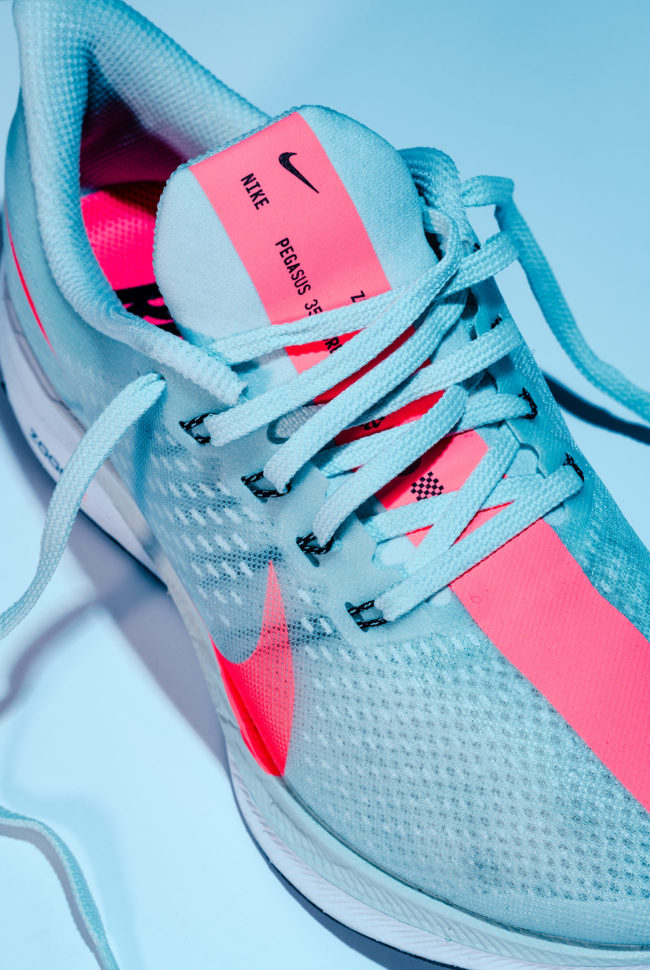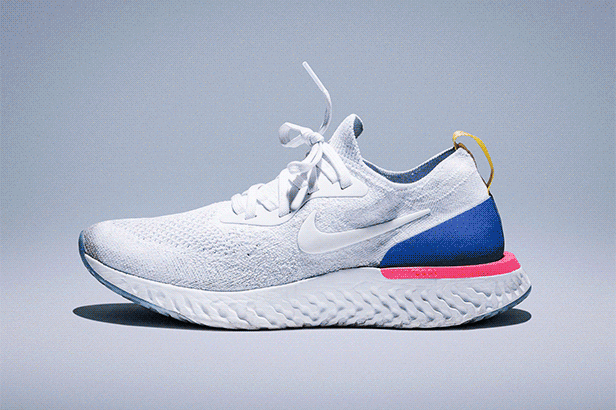Since the launch of Nike’s ZoomX foam almost two years ago, elite runners like Eliud Kipchoge have been running in shoes utilizing that foam and winning marathons. However, the Vaprofly 4% shoes (which were the first with ZoomX foam) aren’t intended to be worn every single day for training runs. The Nike Pegasus Turbo is the solution to that problem. The Turbo is an everyday trainer that combines the ZoomX foam with the popular Epic React foam for a much more approachable price point of $180.
The Good: In light of the recent New York Times piece that showed a positive correlation between the VaporFly 4% and faster half and full marathon times, the desire to buy the 4% shoes for an upcoming race makes a lot of sense. But you shouldn’t wear them for your training runs leading up to the big day. The Pegasus Turbo fills that gap — it’s the shoe you’ll reach for on tempo days, on long training runs and as an everyday trainer. The Pegasus Turbo weighs less than 9 ounces (less than a can of soup) which helps you feel fast (feeling fast often translates to actually being fast), and the look mimics the feel.
Who It’s For: If you’re training for a race, this sneaker is for you. It has more support in the upper compared to the Epic React, but a similarly plush and soft feel. The marshmallow-like feel of the React is replaced with a springy bounce in each step, propelling you forward for 100-meter repeats, 5Ks in the rain or race days across bridges. If you’re a die-hard Pegasus trainer, the first step feel of the Turbo is mostly the same as the Pegasus 35, if not a bit more airy (the Pegasus Turbo is almost a full ounce lighter than the Pegasus 35). If you’ve been wanting the VaporFly 4% since they launched, and have yet to splurge on a pair, this is a good compromise.
Watch Out For: Similar to the Pegasus 35, there’s an extended heel collar, which helps eliminate pressure on your Achilles tendon but for some, it might feel uncomfortable. You may have some tightness around that area, depending on the shoes you’re used to running in.
There’s ample forefoot room (more so than the Pegasus 35), but sizing can be tricky. I usually size up in Nike kicks by half a size, but kept with my regular size for these.
Alternatives: If you like your running shoes to provide a bit more support, try the Pegasus 35 ($180). If you’re looking to get a similar feel to the ZoomX foam with that semi-plush cushioning, yet springy feel, try the Adidas Adizero Sub2 ($180+) or the Reebok FloatRide Run ($140) — both of which are race day ready for normal humans who don’t want to shell out $250 for a pair of race day shoes.
Review: Right out of the packaging, the shoes felt smooth and light thanks to the combination of ZoomX and React foam. Nike calls the ZoomX foam its “unicorn foam” as it’s the “lightest, most responsive foam we’ve ever used in a shoe,” Chris Nuelle, an EKIN for Nike (a group of Nike employees tasked with brand storytelling and marketing), explained to me. There were no tight spots, just plenty of room in the toe box compared to the toebox of the Pegasus 35s (that I’ve most recently been running around NYC in). Stepping into the shoes, I had no immediate issues — no rubbing, chafing or tightness in my toes, heels or top of my feet. The cushioning underneath felt plush and soft, but not wobbly as is described with the VaporFly 4%. There’s also no plate underfoot, as there is in the 4%.
The semi-translucent upper features a pink racing stripe down the middle to give it a fast and aerodynamic look. “You can actually see the FlyWire and some of the inner workings of the shoe. Think of those sports cars where you can see the engine in the back,” Nuelle said.
On a 5K through the city, it was easy to test out lateral movements and quick starts and stops. I could easily monitor the Pegasus Turbo’s sole traction under less than ideal running conditions, seeing as it had rained right before my run and continued to drizzle throughout. While I felt a little unstable on freshly wet concrete, I didn’t slip or slide once.

While the Pegasus Turbo’s roots come from the VaporFly 4%, this shoe works for everyday runs and runners. Nike worked closely with Eliud Kipchoge, who most recently won the London Marathon and came within 25 milliseconds of Breaking2 (the sub-two-hour marathon challenge Nike launched almost two years ago, and the birth of ZoomX foam), to create these shoes as an alternative to the 4%. “After racing in the shoe, [Kipchoge] said, ‘I want the magic of that shoe in my everyday training shoe,’ so we took the plate away and made the shoe for everyday runners,” Nuelle explained. Directly underfoot, the Turbo features a dual-layer of foam with the ZoomX foam and then the React foam. “ZoomX is right under your foot, so that gives you race day feel, but you get more durability out of it with the [additional] layer of foam under it,” Nuelle said.
I’ve been running in these shoes for about a week now, and they are fast. Beyond just looking speedy, there’s no break-in period, and the bounce I feel with every step makes me want to reach for these for every single run.
Verdict: Long story short, if you’re looking for an advantage in an upcoming race, these are the shoes you should train in. And if $250 is too much to drop on a pair of the VaporFly 4%, the Pegasus Turbo sneakers are worth testing for race day.
The shoes are available for purchase to NikePlus members as of July 19th, and will be available to the general public starting August 2.
What Others Are Saying:
• “In the Runner’s World Shoe Lab, we found its energy return to be on par with shoes using Adidas’s Boost midsole. That’s going to deliver you a bouncy, fast sensation underfoot, even though ZoomX is much lighter than Boost.” — Jeff Dengate, Runner’s World
• “After running for about a month before in the Pegasus 35 (not hungover), I can definitely feel the difference in cushioning. The Peg 35 uses a full-length Zoom Air bag which has a more snappy feel underfoot, while the Turbo gives a more plush, cushioned ride.” — Gerald Flores, Sole Collector
• “Overall, running in the Zoom Pegasus Turbo is a joyride. The outsole is reliably grippy. I love that it provides the cushion of a support shoe with the lightness of a racing flat. The main takeaway was an overwhelming sense of efficiency. You can grab these to tear up the track for 200 repeats or whiz through a mid-distance run.” — Brittany Smith, Men’s Journal
• “These definitely feel “snappy” and are as responsive as the Adidas UltraBOOST, which I used to wear a lot. (In my less-than-scientific analysis, I did run slightly faster in these than the regular Nike Air Zoom Pegasus Turbo — but who knows why!) So, I could definitely see them being good for speed workouts or race day. Compared to the Nike Epic React, these feel more supportive and cushioned, even though they technically have the same “offset,” which is the amount of foam between the forefoot and heel, Nuelle said. In my experience, the Nike Epic React fell a little flat over time, perhaps because the sole is made of one piece of foam. The Zoom Pegasus Turbo, on the other hand, has better traction underneath the foot, which might make you feel like you have more support.” — Cory Stieg, Refinery29
Key Specs
Offset: 10 mm
Forefoot Stack: 12 mm
Weight: 8.6 ounces for men’s 10; 6.9 ounces for women’s 8
Colors: All black or white with pink racing stripe
Hot takes and in-depth reviews on noteworthy, relevant and interesting products. Read the Story





